|
|
Post by us4-he2-gal2 on Jun 6, 2008 5:17:47 GMT -5
Thread Orientaton: This thread is a record of enthusiasm for the written language of ancient Mesopotamia. It is intended to re-enforce the notion that 'an intelligent mind can learn anything with a good book' (as expressed in Snell's introductory remarks), and to propose a possible alternative for anyone quiet bored with "jeopardy" reruns out there.. 0_0
In practice, theres nothing the zealous can't approach imo.
|
|
|
|
Post by us4-he2-gal2 on Jun 6, 2008 13:14:51 GMT -5
Us4-he2-gal2's Cuneiform Diary Before Cuneiform/ I have been fascinated with Sumerian studies for some time, but for much of the early time it was unusual to see cuneiform itself in my reading. Many introductory books will describe in varying detail, the problems experts have in deciphering this or that cuneiform text or genre. Sometimes an introductory book will contain line art to illustrate these problems, or the rare photo of a cuneiform tablet - yet most often the reader (even the well read) finds this little use in practice. Without a study of the signs they are overwhelming strange looking.. if not outright bewildering. I had the fortune of meeting and corresponding with some very interesting people online, as well as a small few in the field. For me, this made my reading much more vibrant and began to accompany my every intellectual effort.. The prospect of community become a strong motivator - a context which I'd been missing outside of university. That what you do may please or displease someone you respect takes on a life of its own, your focus now has a frame of reference.. especially when outside of these little exchanges your strivings are all but invisible to the world at large, it is important. I enjoyed sifting through the secondary literature, and my slow steady approach to academia (which floated always ahead at some imperceptible distance, like a mirage) would soon be strangely augmented. Could any but the strangest of sorts deliver to me that enigmatic and evasive taste for cuneiform writing? 0_0 During Cuneiform/ To witness Frank Merten (Sheshki) as an amateur cuneiform enthusiast is to reconsider that cuneiform is hands off for the layman; that it is hopelessly out of sight and reach for the enthusiast... This man has cuneiform on his teapot! And a good many other this for that matter. He proved to me that with a steady focus it is possible know hundreds of signs, Sumerian and Assyrian, and their values, and that this feat can be achieved anytime and anywhere this certain enthusiasm exists. I am very appreciative of this inspiration as even before my studies begin, or the trial of language acquisition begins, to know the cuneiform signs and their values will be something of a comfort. At Frank's suggestion I have begun by studying D. Snell's 'A Workbook of Cuneiform Signs". This book is very simple in design and concept - each Neo-Assyria sign (and there are over one hundred) is given in form, and the learner is required to do a small transliteration of this new sign next to a few others already learned, and then towrite the sign out up to 20 times or so. After this little practice, you move on to the next one.. However to really retain your memory of the signs, and to support an ever growing string of them, additional practice and writing is required elsewhere. I have to date learned 43 signs, and continue toward mastery of Snell's book. Those signs according to the value's Snell gives, and the order in which I practice them are:
aš, nu, ba, zu, ka, la, ad, tu, li, AN, ru, qe/qi, mu, be, ti, hu, nam, ik, re/ri, zi, gi, en, tim, ak, šum, ab, sa, iku, gur, si, sag, uk, as/az, um, ta, i, ia, DUMU, at, şi, šar, am, bi2/ne
Because I work a crappy job often for 11 1/2 shifts, alot of my practice is done there. It is a "paperless" environment meaning I'm not allowed to have paper during that 11 1/2 hours, and so I have had to write cuneiform on other things. Often, I will write it on my hand: Other times I am able to write on a Dry-erase board with a big marker. Most of my co-workers consider this my 'Chinese character' writing board, yet to date, no one has asked me for a fortune.. perhaps it is because I don't have a cookie to go along with it. And lastly, I display below some pictures of my practice book at home. After learning a new sign or two at work I try to record this progress by adding to this book, to the sign list (the big cuneiform pages), and to follow that by doing the Snell exercise again on following pages. My practice book is not yet like the ones Frank has, but my practice is still comparatively young. In time I hope we will be transliterators, copyists, and indeed, translators. Such a hopeless optimist...  |
|
|
|
Post by sheshki on Jun 8, 2008 20:19:29 GMT -5
Sheshki's Cuneiform Diary Before cuneiform/ Well, I was always a bit interested in history, but focused on other things. I had always a strange attraction to strange looking letters. As a kid my grandmother taught me to read and write sütterlin ( en.wikipedia.org/wiki/Sütterlin) a kind of writing that was very common in Germany before the Nazi time. I also had Russian at school for 5 years. I didn't like it much but was good in it. The letters seemed to look interesting enough to keep me learning  Some years ago I came across Mesopotamian history during research for a cd cover-artwork.. and there were those strange looking, beautiful signs. And I was set on fire.... I searched through the internet but when you have no idea what to look for it's hard to find something.... So, one day I found D.C. Snell's Workbook of Cuneiform Signs (Us4-he2-gal2 spoke about it) in pdf format, and I was ready to start. During cuneiform/ There are several reasons that I started to learn those signs. 1. As a kid I always wanted to have a secret writing system. I made some, but in the end it was only the normal alphabet in strange shape...so cuneiform was kinda perfect  2 2. Well, as I looked through Snell's book for the first time there was this quote, that an intelligent person can learn anything with a good book...he got me with that  3 3. When I saw two signs from a stele of manischtuschu in one of the books I bought on ebay, lugal and kish, I was like...wow...how beautiful...I want an cuneiform tattoo...it was written in that royal inscription style...now I have one and the next one is in planning... 4. I just wanted to know what my old brain is able to learn ... 5. I had no other choice because I was addicted when I first saw em...the signs... So, I started to learn with Snell's book. I wrote em down, again and again, most of times in groups of 3-4 signs. After a while I realised that the names of the signs I learned are like a poem, for better understanding, here are the first lines of the cuneiform poem: ash ba zu
ka la mu
an nu tu
li qa ru
be na ti
hu nam ik
etc.
I have to say that to learn it like a poem helped alot. The more I learned the easyier it was and some parts of the signs return in some way or another. I don't know exactly how long it took to learn through Snell's book...I think maybe a year... So, I was through with the workbook and I was very proud of me  After that I looked around and found R.Borger's Mesopotamische Zeichenliste. My brother owns a bookstore...fortunately, that helped me to save some money because that was the most expensive book I'd bought so far... I continued learning signs using Borger's book, filled hundreds of sheets with it. I stopped when I was at around 300 signs. Some month ago I started to create the enenuru signlist and I was very attracted by the Sumerian signs, so I started to learn the same signs in Sumerian. but I'm a bit stuck here... So if anyone out there is inspired now to try it, remember this: You must practice daily or your getting in touble someday:) I had a break of about 8 months and it took me weeks to get back on the same level as before. And right now I'm at the end of a longer break and the re-learning starts again. And.. Somewhere I have a picture of the teapot Ush4 mentioned  Wanna see?  ;D I love cuneiform ;D |
|
|
|
Post by sheshki on Jun 10, 2008 9:57:15 GMT -5
one thing i forgot. practicing cuneiform writings has a very meditative effect on me. i like that much.
still searching for that teapot pic...maybe i should just make a new one.
|
|
|
|
Post by sheshki on Jun 11, 2008 2:21:49 GMT -5
here is the teapot. 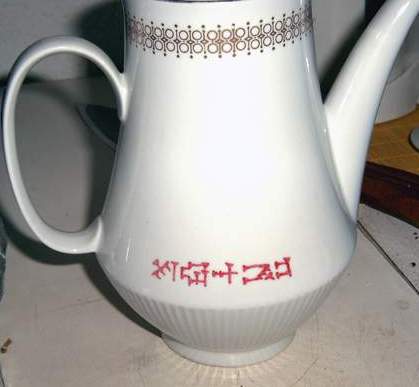 btw, it says "te-ka-an-ne" which is for teekanne (teapot) so i used cuneiform for german. sometimes i also do my shopping lists in cuneiform....or parts of it....its fun to remember at the store  |
|
|
|
Post by sheshki on Jun 18, 2008 6:33:05 GMT -5
well, here is a small video (49mb) of me writing cuneiform. its not that easy to film and write... www.enenuru.net/sheshki/board/magic_pen.MPGwhile writing the very last line [d inana za3 mi2] i was looking through the cameras lcd display, thats why the writing looks a bit shitty  |
|
|
|
Post by sheshki on Jul 19, 2008 19:16:36 GMT -5
since a month i relearn my beloved signs, because i took a longer break...almost six month. i try to practice them daily but i fail sometimes on this...so right now im at 234 signs (out of 300 i knew before) i can draw and name (except most of the numbers...like kad4 kad5 or buru15 or whatever...) out of memory...its good to be back in practice...how is it going with you ush? 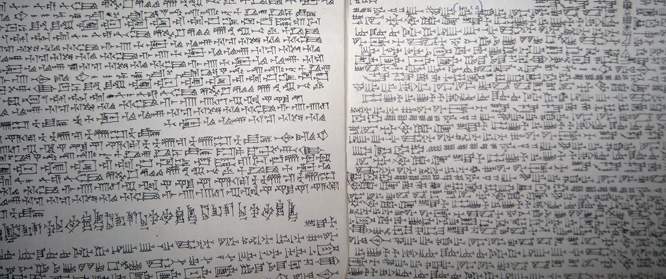 |
|
|
|
Post by sheshki on Jul 27, 2008 18:01:41 GMT -5
Hello enenurians, today i wrote on clay for the first time. i used a chopstick  The claypiece itself is 5x6cm. inanna be praised! za 3 (second line first sign) should have 4 strokes in the middle and on the left side....but there wasnt enough space .... 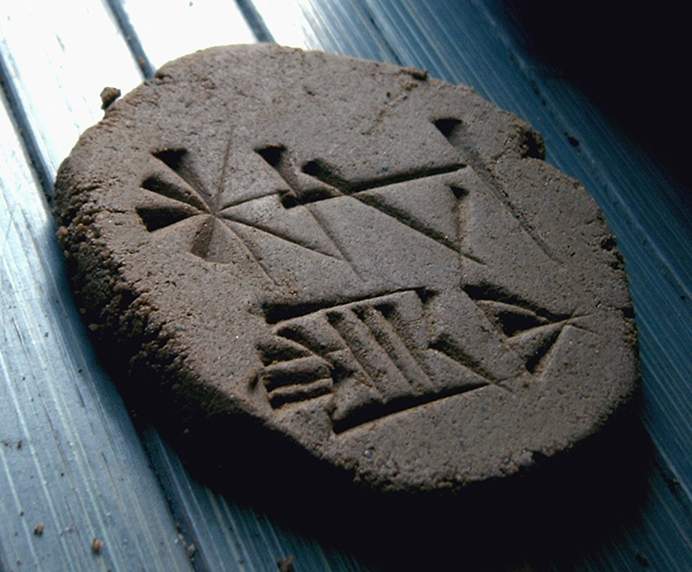 |
|
|
|
Post by us4-he2-gal2 on Jul 31, 2008 21:03:49 GMT -5
Heya Sheshki (Hi Naomi!) Thanks for asking Shesh - my cuneiform study is going good I think! I am now at 65 signs, and I wrote my first english sentance phoneticaly by using cuneiform signs recently! Check it: it-ish-a bi-ir-du .... ? YES! weeee... It ish a birdu. Ooookay. (I know, Im that good 0_0) Also lately I have learned the cuneiform signs for LU2 (man) and e2 (residence) and am very happy to finally see and use these 
By the way - did everyone see that Frank is opening an e2-dub-a? Woohoo! Cuneiform tablet making ! You are the man Frank  He made me an us4-he2-gal2 tablet - maybe he's taking requests? |
|
|
|
Post by sheshki on Aug 1, 2008 14:22:39 GMT -5
ah, nice sentence.  ur making progress, ush.... I made two new objects. well, right now i have so much clay that i decided to make balls of clay and dry em for later use. and i couldnt resist to put some cuneiform at it...  the round one has a bunch of signs that came to mind as i was writing em, on the other one i wrote down the signs of my tattoo. 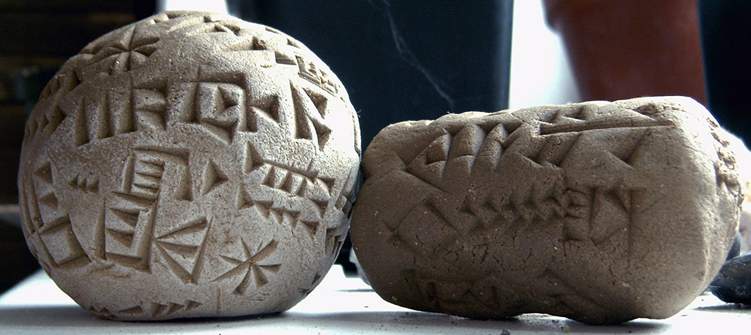 here you can see dingir-nin-gish... under it shesh-ki 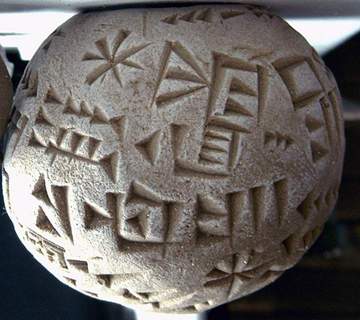 here u can see the date, right under the hole. 31.8.8 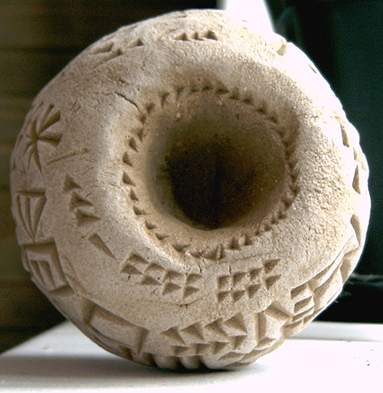 fun with clay is all i say  oh, and, next plan is to make a cylinder seal...out of clay of course  i almost forgot this one: lu2 us4-he2-gal2 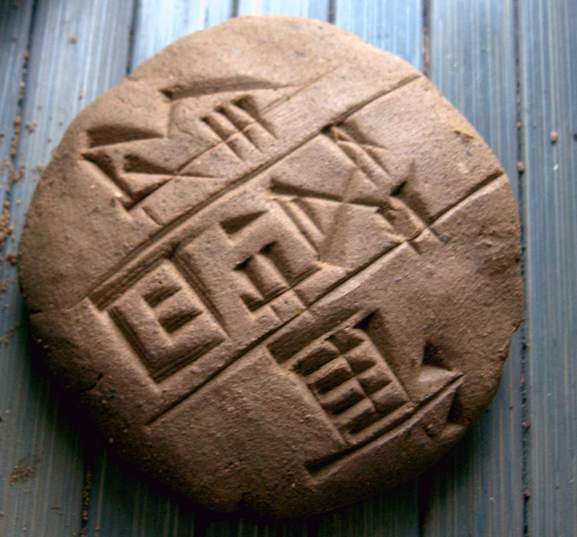 |
|
|
|
Post by sheshki on Aug 15, 2008 7:50:44 GMT -5
Two days ago i was at my mums place, same place where i grew up. And there it struck me like a lightning...small one of course. I remembered that, as a kid, i found our glassdoors very interesting for some unknown reason. I looked at them often, tried to find out if it could mean something...what the heck is he talking about u might think now, but take a look and tell me...dont they look like huge cuneiformtablets;)...and i bet somehow they influenced me later. 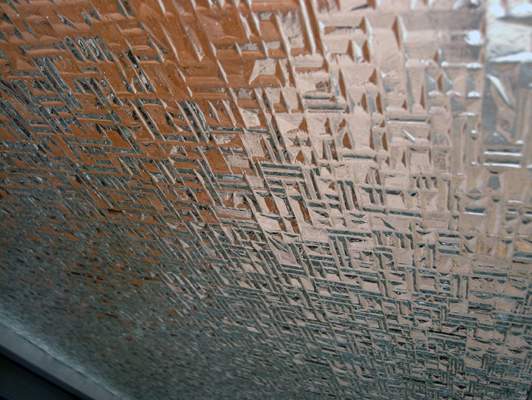  |
|
|
|
Post by shupuwhenip on Aug 15, 2008 16:44:40 GMT -5
I also used Snell's 'Workbook' when I was learning the sign list. Started at the beginning of summer and memorized one a day. After doing the page from the workbook I'd write it out 50 times on a piece of paper, then take another piece of paper and write all the signs I'd memorized up to that point (as you can guess it started easy and got hard).
On my first day of class my prof was horrified when I told him I'd used Snell. He tried telling me the signs were too different from Borger's but in reality there were only maybe 5 out of 150 signs that didn't match. My prof was kind of eccentric, I think he just didn't like Snell for some reason.
|
|
|
|
Post by sheshki on Aug 15, 2008 17:51:08 GMT -5
Interesting. I also found some signs that didnt match with borger, but not much. NE comes to mind which is in snells book BI2 i think. hey, did you had a chance to have a look at the signlist at enenuru.net listIt sounds like your skilled with the knowledge of the signs, so maybe u find errors there  |
|
|
|
Post by shupuwhenip on Aug 15, 2008 19:56:55 GMT -5
Interesting. I also found some signs that didnt match with borger, but not much. NE comes to mind which is in snells book BI2 i think. hey, did you had a chance to have a look at the signlist at enenuru.net listIt sounds like your skilled with the knowledge of the signs, so maybe u find errors there  I'm afraid it's been a couple of years and now my cuneiform is rusty  I still work with Akkadian but usually rely on other authors' transliterations. I'd need a crash course to remember anything more than a couple of signs. I can still spell Summa Awilum though! ;D |
|
|
|
Post by sheshki on Aug 15, 2008 21:03:20 GMT -5
Well then maybe looking at the list will help you refreshing your cuneiform skills  |
|
|
|
Post by sheshki on Aug 16, 2008 13:51:07 GMT -5
enenurians, today i made a very important invention  i found out that it is possible to write cuneiform on butter, if it´s fresh out of the fridge. so this is the chance for all of you who live in areas without natural claysources to practice. nobel prize, i hear you calling   btw, icecream does not work well...melts too quick and ...ahem ...tastes too good |
|
|
|
Post by amarsin on Aug 16, 2008 13:54:06 GMT -5
I also used Snell's 'Workbook' when I was learning the sign list. Started at the beginning of summer and memorized one a day. After doing the page from the workbook I'd write it out 50 times on a piece of paper, then take another piece of paper and write all the signs I'd memorized up to that point (as you can guess it started easy and got hard). On my first day of class my prof was horrified when I told him I'd used Snell. He tried telling me the signs were too different from Borger's but in reality there were only maybe 5 out of 150 signs that didn't match. My prof was kind of eccentric, I think he just didn't like Snell for some reason. Who was your professor? The objection seems to be sort of odd. Obviously, real cuneiform was never typeset or anything, and what you see on a tablet is usually going to be a little different from what you find in a sign list, be it Borger or Labat, or a workbook like Snell's. And of course, since real signs are done 3D in clay (and not 2D on paper), no amount of sign-memorizing will help as much as looking at the real deal. |
|
|
|
Post by shupuwhenip on Aug 16, 2008 14:38:31 GMT -5
I also used Snell's 'Workbook' when I was learning the sign list. Started at the beginning of summer and memorized one a day. After doing the page from the workbook I'd write it out 50 times on a piece of paper, then take another piece of paper and write all the signs I'd memorized up to that point (as you can guess it started easy and got hard). On my first day of class my prof was horrified when I told him I'd used Snell. He tried telling me the signs were too different from Borger's but in reality there were only maybe 5 out of 150 signs that didn't match. My prof was kind of eccentric, I think he just didn't like Snell for some reason. Who was your professor? The objection seems to be sort of odd. Obviously, real cuneiform was never typeset or anything, and what you see on a tablet is usually going to be a little different from what you find in a sign list, be it Borger or Labat, or a workbook like Snell's. And of course, since real signs are done 3D in clay (and not 2D on paper), no amount of sign-memorizing will help as much as looking at the real deal. I don't want to say his name because that would identify me but he's one of only two Akkadian profs at ####. Ideally we would have used 3D imagery (or even just photos) of cuneiform texts but that wasn't feasible and using Borger allowed everyone in the class to work with the same material. I agree the objection was odd and kind of pedantic. If I was to do it over again I'd still use Snell, though next time I'd write in pencil or use photocopies so I could reuse the workbook. |
|
|
|
Post by us4-he2-gal2 on Aug 16, 2008 22:00:25 GMT -5
Amarsin: This point you've raised a few times, and it is probably very good one, that is the difference between memorizing the signs and reading them from a 3d object - this is undoubtedly an insight that comes from personal experience. I will have to figure a way for the cuneiform learners here to work this in to the practice hm.. Shupu: I do love to hear any perspective on studies at the U of T. And about identity, I had some of the same reservations when starting out here, you wonder how helpful your morally allowed to be. Eventually I find very little obstructs my good intentions, you'll find the same I think.  Sheshki: I LOVE that butter post. You kill me man lol ;] Im adding this one to my Frank's greatest cuneiforms folder! |
|
|
|
Post by shupuwhenip on Aug 17, 2008 0:29:48 GMT -5
Shupu: I do love to hear any perspective on studies at the U of T. And about identity, I had some of the same reservations when starting out here, you wonder how helpful your morally allowed to be. Eventually I find very little obstructs my good intentions, you'll find the same I think.  In my humble opinion, there are better universities than UofT to study Akkadian at. There's only two Akkadian undergrad courses, Sumerian is rarely offered, and there's only two Akkadian professors. But that's my opinion for a philologist, someone who would make the language the focal point of their program. Ideally, with the right timing, there's still 4 years worth of language studies - first year in Hebrew or Arabic (a prerequisite), then 2 years of Akkadian followed by one of Sumerian. And there's always the option of independent studies under one of the professors, which a classmate of mine does. The same classmate is also leaving for Germany at the end of the month for a year-long crash course in Sumerian, Hittite, Hurrian, and of course more Akkadian. For those interested in ANE history and archaeology (like me) UofT is a good choice. Not least because there's several digs undertaken each year (this year they were in Turkey near Syria, Egypt, Sudan, and Jordan) and the school is linked to the ROM (Royal Ontario Museum). There's also a pretty good GIS and archaeo-physics department if you're into the technical side. This last point is probably doesn't interest many here but it's a very good school for Egyptology, as well as general Levantine studies (aka Palestine aka Biblical). Egyptology is probably the backbone of the department, at least the ancient part of the department, and they have about twice as many courses as Assyriology. One word of caution though: UofT's NMC department is starting to follow the bucks and offer more modern language courses at the expense of the ancient. One of the Akkadian profs will be hitting tenure soon so there's no danger of it disappearing, and UofT is a huge prestige whore so they'll continue funding digs, the RIM, and contributing to SAA, but I wouldn't be optimistic about Sumerian being offered in the near future. Going by every 4 years, it should have been offered this September but it's not. Regarding you second point, my morality regarding copyrights is still evolving  A couple of good articles on digitization efforts has gotten me thinking that I shouldn't wait for copyright laws to get settled before tracking down more books in pdf format. Sitting on our hands won't do much good; we can be pretty sure our field will be one of the last to be scanned, probably after they do old classified ads and Eaton's catalogues. I think the more information that's available, the more people will get interested, more will study it and produce research, and we'll all be the better for it. I think Geller would understand if someone put up the Forerunners to Udug-hul; he might just get pissed if his new book appears on the internet anytime soon. |
|
|
|
Post by shupuwhenip on Aug 17, 2008 15:37:44 GMT -5
Sumerian students are weird. Which begs the question, does Sumerian attract weird people or does studying it make you weird? |
|
|
|
Post by sheshki on Aug 18, 2008 4:18:46 GMT -5
Well, actually its neo-assyrian writing style used for a german/english word. So a very normal thing (at least inside my walls  ) |
|
|
|
Post by sheshki on Aug 28, 2008 9:34:06 GMT -5
after spending so much time with royal inscriptions at cdli (what a wonderful database  ) i felt like creating my own royal inscription. this time i used a triangular shaped file. so here it is. 1. sheshki 2. lugal of kish 3. lugal of ur 4. lugal of adab 5. strong lugal 6. son of ebi (this is my daddys nickname) 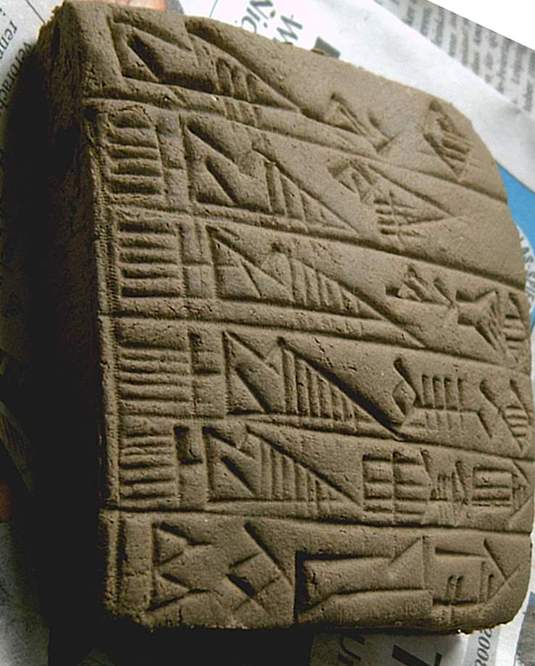 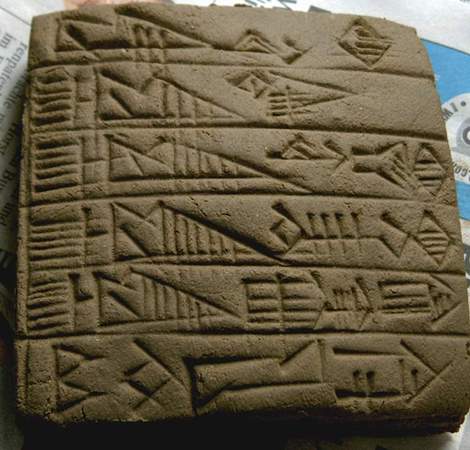 oh and , i almost forgot, i made a first try of creating a rolling seal out of clay. but i think i need to raise skills here.  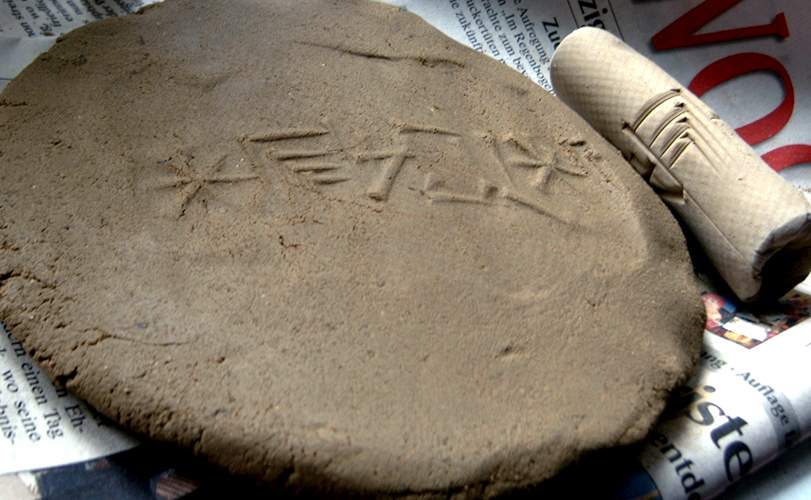 fun with clay! |
|
|
|
Post by us4-he2-gal2 on Aug 28, 2008 10:23:08 GMT -5
WOW! Frank you are truly astounding!  You're interpreting and becoming familiar with roya inscriptions has amazed me as much as it has sunk my mail box - and these tablet making efforts are truly special and wonderfully eccentric - you must be the first king in 2 millennia and some change with his own Mesopotamian royal inscription and seal!  We should make a galley for this stuff at enenuru.net |
|
|
|
Post by sheshki on Aug 28, 2008 15:36:44 GMT -5
thanks ush,
but this is not my royal cylinder seal. take a closer look! what is written there...
you should know it!
|
|
|
|
Post by sheshki on Aug 28, 2008 15:59:21 GMT -5
ack, i just saw that i made a mistake on my tablet...i wrote kalam-ga... but it should be kal-ga (strong king)...i hope the clay is still wet enough to fix that ---------------- well, the clay was still wet enough.and it was easy to correct the error (btw, i wrote that all out of mind, except kalam-ga, which was wrong, so more errors are possible). i wonder if faked or afterwards edited claytablets have been a problem at those times. another thing i learned during my "fun with clay" sessions that it is not that easy to get the clay in perfect writing condition. for example if the clay is too wet it sticks to the writing tool. there must have been people at those times who were responsible for all the clay the writers needed...  |
|
|
|
Post by us4-he2-gal2 on Aug 28, 2008 21:43:52 GMT -5
I acutally hadn't tried to read what it said - but now that I do that's an en2-e2-nu-ru seal isn't it! oh awesome! Can we get more photos of that? Dark backing is good ;]
|
|
|
|
Post by sheshki on Aug 29, 2008 6:52:41 GMT -5
yes, your´re right ush.
problem is that the "cylindersealtest and my royal inscription
(we need to add me to the list...i want my own dynastie!
mayb i should smuggle this into some museum to find my
way into scholarship... ) are the same piece of clay...
so. no more pictures of it. but i can water some clay
and make a new try...or i water the seal and make it anew.
btw! this is my post number 100! do i get another star...? |
|
|
|
Post by us4-he2-gal2 on Sept 23, 2008 9:35:38 GMT -5
This week Sheshki challenged me to decipher a new Cuneiform tablet he had created and inscribed: straight from Frank's Kitchen e-dub-a! (One would think 'surely he's making cookies - but no, a cuneiform tablet filled with archaic script comes out). This time I was set against Lara's transliteration time of 30 mins or so and challenged to beat it or keep up - we both used "the list" found at enenuru.net (the sexiest sign list in the world) and worked to transliterate the tablet. It was tense for a few minutes as I looked through the numerous choices of different orthographies on the list - and at the same time was bewildered by the scribes apparent lack of standardized spacing on the tablet (I think an authentic feature!) but eventually I emerged with a good transliteration - YES!! But.. Did I beat Lara's time? Lets just say it was neck and neck and it could have gone either way! (that's more dramatic.) |
|
|
|
Post by sheshki on Sept 23, 2008 14:40:57 GMT -5
i just watered some clay for a board challenge inscription  |
|